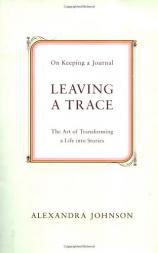Reading Group Guide
Discussion Questions
Leaving A Trace

1. On a separate sheet of paper answer the following six questions: How did a journal first come into your life? Who gave it to you? What was the occasion? Where did you buy your first journal—in a drug store, stationery store, or specialty shop? What did it look like? Be specific and include details, like the cover and the lock. Whether it's a journal, the back of a Visa slip or Post-its, what do you now use to write down occasional thoughts? Imagining your ideal journal (2-4 minutes)
- 2. Choosing a journal is a special ritual for many. Take a minute to note some favorite types. (Classic hard-bound journal, pocket-size journal or 79-cent notebook). What's your ideal time and place to write? (At night; on the subway home; at the stroke of New Years).
-
3. List all the ways you can now imagine a journal being—photo collage with no writing; dream journal; nature journal. Chapters One and Two focus on all the forms a journal can take.
Group Writing Activity: Part one (10 minutes)
- 4. List four incidents that were never recorded in your first or earliest journals. It may be a family trip or a first day in school; a summer crush or a moment when life was suddenly different, after a sibling's birth, for example. Select one incident. First just get the facts down. Highlight three key facts. Now sketch the fuller memory. An important trick: don't let the pen lift until you've gotten to the bottom of the page.
-
5. List all the dead spaces in a day, all the time you spend waiting in a day. For example, waiting to pick up kids or for a meeting to start. This will give you a list of times when you can do many of the quick journal writing exercises in Section One.
Group activity: Part two (5-10 minutes)
Finding patterns: Part three (10-20 minutes) Section Two shows how to find patterns even in abandoned, half-filled journals. Even if you've kept a journal for years, do these two simple sketches that will map important memories.
- 7. Think of an object that has special meaning for you. It may be something you keep on a desk, or the first thing you'd rescue in a fire. Describe the object to a stranger who's never seen it. If it's a photo, for example, is it black-and-white or color? Who's in the photo? Who's missing? Fill one or two pages. Again, don't let the pen lift from the page. When you have finished, write a single sentence about why the object has such meaning for you.
-
8. Remember a favorite place, somewhere you often go back to in your memory. It may be a childhood haunt—a grandparent's porch, a summer cottage, or somewhere you like now. The house in which your first child grew up, for example. List two details for each of the five senses. Brainstorm things a stranger would notice: faded wallpaper, the smell of lemon and bacon in a kitchen. Why is this place so special in your memory? -
9. You now know how to build on such quick sketches and move them into full creative work, as shown in Sections Two and Three.
Final Group activity (10 minutes) Share which object or place you selected. What impressions or memories were triggered? Expanding a journal's range
- 10. Begin a joint e-mail journal with a close friend or family member. Print out and collect into a three-ring binder.
-
11. Interview a family member who has never kept a journal as a way to start a family chronicle -
12. As part of a school or community project, pair with someone in a hospital, retirement or nursing home and use a journal to record their life's story. Keep a journal of how the process has helped you re-see your own.
Leaving A Trace
- Publication Date: March 6, 2013
- Hardcover: 256 pages
- Publisher: Little, Brown
- ISBN-10: 0316120200
- ISBN-13: 9780316120203







